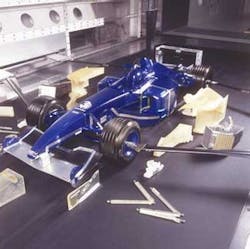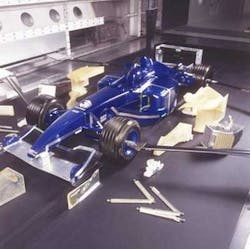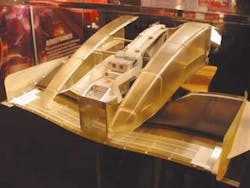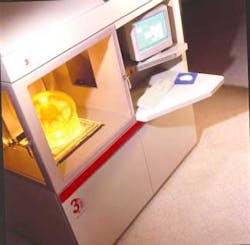Lasers help Formula One cars race faster
Formula One racing is said to be the second most popular worldwide sporting event, just behind the game we Americans call soccer. Each week during the season, the Formula One race draws the largest television audience, said to be in the hundreds of millions. And yet for all its popularity Formula One (F1) racing may have fallen into a trap, albeit a dollar-lined trap. Put succinctly, as stated in a recent article in The Economist, it's a . . . "non-event, like watching paint dry."
Although racecar performance can vary greatly—the winner can often be more than 30 seconds ahead of the second-place car—one knowledgeable fan comments, "The race is to see who gets to turn one from the start first. After that it is just a procession to the finish, barring a crash or equipment failure."
Perhaps that explains why Formula One is not as popular in the United States. NASCAR officials realized they too were settling into a similar scenario at its super speedways, a train of high-performance cars, nose to tail, lap after lap, just waiting for a disaster to change the order. But NASCAR constantly adjusts the rules to improve competitiveness, thereby raising viewer interest, making this type of racing number one in the U.S. Formula One being more like a personality cult focuses more on the driver and the glamour crowd that trails after him. It has been suggested that Bernie Ecclestone, the power that controls Formula One, should tell the television crews to focus more on the drivers and his fans than the race.
Lest you think this is anti-Formula One racing, think again. Federation Internationale de L'Automobile (FIA), the governing body, also knows that competitiveness is what attracts supporters, not crashes and not preordained finishes. The F1 race teams also know that competitiveness is the key, as evidenced by the hundreds of millions of dollars each team spends to field two racecars for the season. These teams hire legions of engineers who spend thousands of hours trying to find ways to make their teams' cars just a millisecond faster into that first turn. One of the tools these engineers have found to be almost mandatory today is the use of laser prototyping and part manufacturing.
F1 is single-seat auto racing, where the car specifications are strictly regulated by the FIA. F1 cars are designed for high speed and cornering on road track layouts, so FIA sets certain controlling parameters such as car weight.
Today there are 11 racing teams that make up Formula One, all headquartered in Europe, each fielding two cars to compete in the 18 events held globally. These teams are competing for points to win the World Championship. Actually there are two championships, one for drivers and one for constructors. The weekly point scoring is based on the following: ten points for first place, six points for second, four points for third, three for fourth, two for fifth and one point for sixth. So with two cars entered in a race a constructor (the team) could max out with 16 points for a first/second finish, while its drivers would receive ten and six points, respectively.
While this makes for exciting racing early in the season it can also lead to dull finishes. Three quarters through this season, points leader Ferrari and its number one driver Michael Schumacher locked up the championships in mid August, with four races yet to be run. Even if Ferrari does not enter a car for the remainder of the season, the team and its lead driver are the champions.
Well enough background. The underlying theme is quite simply speed, and in this case engineering. What a team spends on engineering often determines how much speed a team can get from its cars. It's not unusual for teams to spend tens of millions of dollars for engineering to address four main aspects: aerodynamics, tires, driver and the engine. But it's not cut and dried. You don't just engineer a competitive car and call it quits. F1 teams work 365 days a year adapting and modifying a car for each track it races on, while they are working in the next season's cars.
Therefore, technology that allows these engineers to produce a competitive car and keep it competitive on any track throughout the season would be jumped on.
In 1995, engineers working on the Renault F1 team (formerly Benetton) recognized that more could be done with laser rapid prototyping than the few parts they were purchasing from service bureaus. The team purchased a 3D Systems (Valencia, CA) SLA (stereolithography apparatus) system. It didn't take them long to see ways in which this tool could enhance their wind tunnel testing (each team has its own wind tunnels). Rapidly producing aerodynamic shapes for body components and more importantly shortening the time to make changes in these components for further testing cost justified the system purchase. Bringing the SLA system in-house saves big bucks because service bureaus can charge 5–10 times the cost for an SLA system-produced part.
Even though Formula One teams are almost psychotic about secrecy, it did not take long for others to catch on to the advantages of an in-house SLA system as a means to improve the form, fit and finish of their cars. The Jordan Grand Prix team quickly purchased a unit and today 9 of the 11 teams owns at least one SLA unit with several operating two or more. 3D systems recently acquired the selected laser sintering process (SLS) system, which provides the capability to prototype, make molds and manufacture the thousands of parts on a typical F1 racecar. And now 3D systems will be offering its OptoForm system (direct composite manufacturing) capability to enhance part manufacturing with new material compounds.
An example, steering wheels. A typical steering wheel can have up to 25 functions mounted on it, not the least of which is the clutch control. An SLA manufactured cockpit-mounted signal device advises the driver when to shift gears by actuating a button on the steering wheel. This frees up one foot so the driver just brakes and accelerates with foot action. Drivers, the highest paid figures in the sporting world, will test a variety of wheel configurations before settling on the one that best suits them. These test steering wheels are prototyped on an SLA system in just a few hours so that minor changes can be made and tested before a final CAD/CAM program is frozen for subsequent conventional manufacturing in the team's CNC machine shop.
And speaking of the driver, each cockpit, where the driver sits, is ergonomically designed using SLA techniques for their individual physique and comfort. What's more their driving helmets are also designed using models produced on an SLA system. In an open cockpit F1 car the driver's helmeted head becomes part of the car's aerodynamics. So team engineers wind-tunnel test various helmet configuration—adding tabs and wind deflectors to make the car totally wind slippery.
Which takes us to the key components of an F1 car, the wing and nose cones. FIA sets the weight maximum, now 1200 pounds, for an F1 car. In their dreams, team engineers would like to have a car weigh about 50 pounds, and through the use of FIA sanctioned ballast, weight the car to maximize its balance for a given road track configuration. Reality is that more parts of a car are carbon composites or lightweight and tough titanium. But a light car, even at 1200 pounds, would fly off the track when experiencing the G forces during rapid changes in direction and elevation. So aerodynamic forces must be applied in a downward direction as the car travels forward, to improve traction and corner handling. Wing-induced forces can increase the car weight to 4000 pounds. Produced on an SLA system, modeled nose cones, wings, spoilers and more are constantly wind tunnel tested. Not only for the current car model, but also to fine-tune a car for specific road conditions throughout the race year.
It's not just aerodynamics that F1 engineers worry about. In any given week they may be challenged to change a thousand car and engine parameters. The Porsche team had concerns that transmission lubricant would get too hot during the 24 hour Le Mans race. So, they used the SLA system to visualize the flow of engine coolant and transmission fluid through the engine and transmission (each done separately). In a separate project, another F1 team wanted to run hydraulic lines directly through an oil tank. There was no room to go around the tank, so they used the SLA system and cast the part in aluminum, which enabled them to run the tubes directly through the tank. Normally, it would be very expensive to create tooling for this geometry, but the SLA system made it easy to build.
Speaking of cooling, F1 car brakes can experience temperatures in excess of 2400 degrees during a race. Cooling ducts are necessary to get air to the brake discs. These ducts must be compact shapes that fit the car body contours while delivering the volume and pressure of air required to keep brakes cool. Several iterations of duct design need to be fabricated and tested before a final design is frozen for routine manufacture. The SLA system shortened the prototyping time while still allowing for last minute design tweaking, at a minimal expense.
The design of 3D Systems' SLA system, which provides a 20 ¥ 20 ¥ 24-inch working volume, allows team engineers to load several part designs into the process control computer using a proprietary nesting program that maximizes parts produced in a given cycle time. This function is one of the most compelling reasons for an F1 team to purchase its own SLA or SLS system, cost per part. SLA systems in F1 applications have shown less than 12 month ROI.
The use of lasers for rapid prototyping and manufacturing has obviously been a major benefit to F1 race teams. However, as an efficient process it has exposed other operations to scrutiny. One technical manager has reportedly said about his SLA system, "Model making used to be the bottleneck. Now the large amount of data available, in such a short time, is the bottleneck."
So what is the future for lasers in the engineering groups of F1 teams? Even though most teams now use an SLA system, many are thinking in terms of the SLS and OptoForm systems to accomplish the desired goal of direct CAD-to-car using sintered metals. 3D Systems has already experimented with some new metal combinations, including a stainless-steel component, which uses a sintered steel compound mixed with a binder that is burned off in processing. Now the pores left from the binder vapors are infiltrated with liquid bronze. In the future 3D Systems expects to develop new alloy compositions that will allow the SLS system to fabricate an expanding array of final metal parts. Already the SL process known as QuickCast is providing a means to produce metal parts from SLA system-produced patterns.
And the company is pushing forward with a new technology known as Advanced Digital Manufacturing (ADM) that will allow direct CAD-to-car component manufacturing. In August, 3D Systems announced a partnership with the Renault F1 team to establish an ADM Center in Enstone, England. This center will utilize the SLA 5000 system that Renault purchased in 1998 and the two SLA 7000 systems it bought in 2000 along with two additional SLA 7000 systems and an Optoform pastes system delivered in September.
The next time you watch a Formula One race on television and you see sleek, aerodynamically designed cars cornering at high speeds consider the contribution lasers have made to the advancement of racecar competitiveness.
The technologies
Stereolithography
A stereolithography apparatus (SLA) system consists of an ultraviolet laser, an optical scanning system, a vat of photosensitive liquid epoxy plastic, an elevator platform and software that controls exposure and position of the laser and the elevator. The SLA system literally builds a physical part—layer by ultra-thin layer—using liquid epoxy plastic that is hardened by a laser to precise specifications.
Selective laser sintering
The laser sintering process begins with a layer of powder material spread over the build platform. Then a CO2 laser selectively draws a cross section of the object on the layer of powder, which sinters (heats and fuses) the material into metal or plastic. The process repeats layer by layer until the part is complete.
Direct composite manufacturing
A joint venture between 3D Systems and DSM Somos, OptoForm LLC focuses on the development and commercialization of new equipment and materials for rapid tooling and direct and indirect in-line manufacturing processes. 3D Systems manufactures and supports the OptoForm system. DSM Somos is the developer of the OptoForm materials. The materials will include ceramics, composite tooling materials and toughened plastics.
The OptoForm systems will be utilized for technical evaluation of tough plastics, ceramics and composite tooling materials for the automotive, aerospace and tooling industries.



